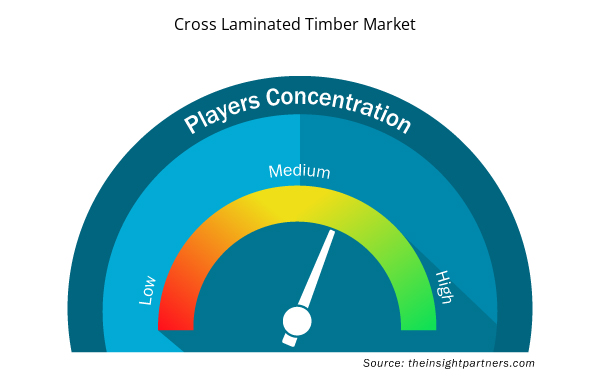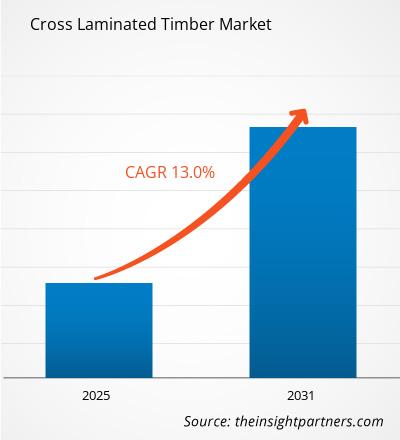クロスラミネーテッドティンバー市場は、2024年から2031年にかけて13.0%のCAGRを記録し、市場規模は2024年のXX百万米ドルから2031年にはXX百万米ドルに拡大すると予想されています。
クロスラミネートティンバー市場は、タイプ、用途、および地域に分類されています。タイプに基づいて、市場は接着結合と機械的締結に分割されています。用途に基づいて、市場は住宅、機関、産業、商業、およびインフラストラクチャに分割されています。レポートの範囲は、北米、ヨーロッパ、アジア太平洋、中東およびアフリカ、南米および中米の5つの地域と、各地域の主要国をカバーしています。グローバル分析は、地域レベルと主要国でさらに細分化されています。レポートは、上記の分析とセグメントに対してUSDでの価値を提供します。
報告書の目的
The Insight Partners のレポート「Cross Laminated Timber Market」は、現在の状況と将来の成長、主な推進要因、課題、機会を説明することを目的としています。これにより、次のようなさまざまなビジネス関係者に洞察が提供されます。
- テクノロジープロバイダー/メーカー: 進化する市場の動向を理解し、潜在的な成長機会を把握することで、情報に基づいた戦略的意思決定が可能になります。
- 投資家: 市場の成長率、市場の財務予測、バリュー チェーン全体に存在する機会に関する包括的な傾向分析を実施します。
- 規制機関: 市場の濫用を最小限に抑え、投資家の信用と信頼を維持し、市場の完全性と安定性を維持することを目的として、市場における政策と警察活動を規制します。
クロスラミネーテッドティンバー市場のセグメンテーション
タイプ
- 接着剤による接合と機械的固定
応用
- 居住の
- 機関
- 産業
- コマーシャル
- インフラストラクチャー
要件に合わせてレポートをカスタマイズする
このレポートの一部、国レベルの分析、Excelデータパックなど、あらゆるレポートを無料でカスタマイズできます。また、スタートアップや大学向けのお得なオファーや割引もご利用いただけます。
- このレポートの主要な市場動向を入手してください。この無料サンプルには、市場動向から見積もりや予測に至るまでのデータ分析が含まれます。
クロスラミネーテッドティンバー市場の成長要因
- 持続可能な建設方法: 持続可能性に向けた一般的な動きが、CLT 市場の主な推進力となっています。クロス ラミネーテッド ティンバーは、コンクリートや鉄鋼に比べて炭素隔離や二酸化炭素排出量の削減など、環境に優しい魅力的な特徴を備えています。建設業者や開発業者がグリーン ビルディングの基準や認証に準拠するよう努めるにつれて、CLT の需要は大幅に増加します。
- 都市化と人口の増加: 新興経済国などの急成長経済では、人口と都市化地域が急速に増加しています。そのため、時間と人件費を効率よく節約できる持続可能な建築ソリューションが必要です。CLT はプレハブ建築資材であるため、建設にかかる時間と人件費を節約できます。都市の発展に伴い、CLT は複数階建ての住宅や商業ビルに最適な選択肢であると考えられます。
- 政府の支援と規制: いくつかの政府は、持続可能な材料を建築に利用することを促進する取り組みを行っています。木材ベースの製品の利用を増やすためのインセンティブ、補助金、有利な規制により、CLT 市場が活性化しています。このイノベーションをリードしているのは、木造建築への投資やその他の投入を支援しているカナダ、ドイツ、オーストリアなどの国々です。
クロスラミネーテッドティンバー市場の将来動向
- プレファブリケーションとモジュラー建築の利用増加: 業界ではプレファブリケーションとモジュラー建築が勢いを増しています。CLT パネルをオフサイトで製造し、現場で素早く組み立てることで、建設業者は廃棄物を減らしてより速い建設という利点を得ることができます。建設業者が効率を好むのは、この理由だけです。効率化によって、高品質を維持しながらコストと時間を節約できるからです。
- スマート テクノロジーの統合の急増: スマート テクノロジーの業界への統合により、CLT 市場は変化します。BIM、ビルディング インフォメーション モデリング、IoT (モノのインターネット) のアプリケーションなどのイノベーションにより、その目的に適した構造の設計、計画、維持が向上します。これにより、持続可能性と効率性を備えたスマート ビルディング プロジェクトに対する CLT の魅力が高まります。
- レジリエンス開発の拡大: 気候変動や異常気象に対する警鐘が高まる中、レジリエンス開発への注目が高まっています。CLT は、その構造性能と耐火性で認められつつあります。両端における CLT の優れた性能は、優れた建物を建てるだけでなく、レジリエンスの高い建物を建てる建築家に対するクライアントの期待の変化に対応します。
クロスラミネーテッドティンバー市場の機会
- 新興市場における CLT 採用の可能性: アジアやアフリカの多くの地域など、伝統的な建築手法の一部として木材を採用していない多くの地域には、潜在的な可能性があります。現地の市場は CLT の利点について認識しており、現地の建設業者とのパートナーシップが確立されています。このような地域では、都市が急速に発展する中で、実用的な建築ソリューションとして CLT がますます採用されることになります。
- CLT とハイブリッド システムを推進するイノベーション: 新しい CLT 製品と、木材と鋼やコンクリートなどの他の材料を組み合わせた新しいハイブリッド システムによって、チャンスが生まれます。この機能には、パフォーマンスとデザインの両方で柔軟性が組み込まれています。エネルギー効率や高度な断熱性のための組み込み技術により、CLT のイノベーションがさらに進み、市場が拡大します。
- 研究開発投資: 研究開発への投資により、CLT の耐火性、防音性、耐久性などの基準の性能を向上させることができます。また、ほとんどの環境条件に合わせて CLT の寿命を延ばす処理の開発にも重点的に研究を進めることで、さまざまな建設用途に適したものになります。
クロスラミネーテッドティンバー市場の地域別分析
予測期間を通じてクロスラミネートティンバー市場に影響を与える地域的な傾向と要因は、Insight Partners のアナリストによって徹底的に説明されています。このセクションでは、北米、ヨーロッパ、アジア太平洋、中東、アフリカ、南米、中米にわたるクロスラミネートティンバー市場のセグメントと地理についても説明します。

- クロスラミネーテッドティンバー市場の地域別データを入手
クロスラミネーテッドティンバー市場レポートの範囲
| レポート属性 | 詳細 |
|---|---|
| 2024年の市場規模 | XX百万米ドル |
| 2031年までの市場規模 | XX百万米ドル |
| 世界のCAGR(2025年~2031年) | 13.0% |
| 履歴データ | 2021-2023 |
| 予測期間 | 2025-2031 |
| 対象セグメント | タイプ別
|
| 対象地域と国 | 北米
|
| 市場リーダーと主要企業プロフィール |
|
クロスラミネーテッドティンバー市場のプレーヤー密度:ビジネスダイナミクスへの影響を理解する
クロスラミネートティンバー市場は、消費者の嗜好の変化、技術の進歩、製品の利点に対する認識の高まりなどの要因により、エンドユーザーの需要が高まり、急速に成長しています。需要が高まるにつれて、企業は提供を拡大し、消費者のニーズを満たすために革新し、新たなトレンドを活用し、市場の成長をさらに促進しています。
市場プレーヤー密度とは、特定の市場または業界内で活動している企業または会社の分布を指します。これは、特定の市場スペースに、その市場規模または総市場価値に対してどれだけの競合相手 (市場プレーヤー) が存在するかを示します。
クロスラミネーテッドティンバー市場で事業を展開している主要企業は次のとおりです。
- バインダーホルツ GmbH
- スマートラム
- ストーラ・エンソ
- シリンガーホルツAG
- マイヤー・メルンホフ・ホルツ
免責事項:上記の企業は、特定の順序でランク付けされていません。

- クロスラミネートティンバー市場のトップキープレーヤーの概要を入手
主なセールスポイント
- 包括的なカバレッジ: レポートでは、クロスラミネートティンバー市場の製品、サービス、タイプ、エンドユーザーの分析を包括的にカバーし、全体的な展望を提供します。
- 専門家による分析: レポートは、業界の専門家とアナリストの深い理解に基づいてまとめられています。
- 最新情報: このレポートは、最新の情報とデータの傾向を網羅しているため、ビジネスの関連性を保証します。
- カスタマイズ オプション: このレポートは、特定のクライアント要件に対応し、ビジネス戦略に適切に適合するようにカスタマイズできます。
したがって、クロスラミネートティンバー市場に関する調査レポートは、業界のシナリオと成長の見通しを解読し理解する道の先導役となることができます。いくつかの正当な懸念があるかもしれませんが、このレポートの全体的な利点は欠点を上回る傾向があります。
- 過去2年間の分析、基準年、CAGRによる予測(7年間)
- PEST分析とSWOT分析
- 市場規模価値/数量 - 世界、地域、国
- 業界と競争環境
- Excel データセット



Report Coverage
Revenue forecast, Company Analysis, Industry landscape, Growth factors, and Trends

Segment Covered
This text is related
to segments covered.

Regional Scope
North America, Europe, Asia Pacific, Middle East & Africa, South & Central America

Country Scope
This text is related
to country scope.
よくある質問
Adoption of prefabrication and modular construction is expected to be the key market trend.
The report can be delivered in PDF/Word format, we can also share excel data sheet based on request.
On the basis of geography, the cross laminated timber market is classified into North America, Europe, Asia Pacific, Middle East and Africa, and South and Central America
Binderholz GmbH, SmartLam, Stora Enso, Schillinger Holz AG, Mayr-Melnhof Holz Holding AG, Eugen Decker, Sterling Solutions LLC., Western Structures, Inc., XLam NZ Limited, and W.u.J. Derix GmbH and Co. are some of the players operating in the market.
The major factors driving the cross laminated timber market are:
1.Sustainable Construction Practices
2. Increasing Urbanization and Population Growth
The Cross Laminated Timber Market is estimated to witness a CAGR of 13.0% from 2023 to 2031
Trends and growth analysis reports related to Chemicals and Materials : READ MORE..
1. Binderholz GmbH
2. SmartLam
3. Stora Enso
4. Schillinger Holz AG
5. Mayr-Melnhof Holz
6. Eugen Decker
7. Sterling Lumber
8. Kattera
9. XLam Limited
10. Derix Group
The Insight Partners performs research in 4 major stages: Data Collection & Secondary Research, Primary Research, Data Analysis and Data Triangulation & Final Review.
- Data Collection and Secondary Research:
As a market research and consulting firm operating from a decade, we have published and advised several client across the globe. First step for any study will start with an assessment of currently available data and insights from existing reports. Further, historical and current market information is collected from Investor Presentations, Annual Reports, SEC Filings, etc., and other information related to company’s performance and market positioning are gathered from Paid Databases (Factiva, Hoovers, and Reuters) and various other publications available in public domain.
Several associations trade associates, technical forums, institutes, societies and organization are accessed to gain technical as well as market related insights through their publications such as research papers, blogs and press releases related to the studies are referred to get cues about the market. Further, white papers, journals, magazines, and other news articles published in last 3 years are scrutinized and analyzed to understand the current market trends.
- Primary Research:
The primarily interview analysis comprise of data obtained from industry participants interview and answers to survey questions gathered by in-house primary team.
For primary research, interviews are conducted with industry experts/CEOs/Marketing Managers/VPs/Subject Matter Experts from both demand and supply side to get a 360-degree view of the market. The primary team conducts several interviews based on the complexity of the markets to understand the various market trends and dynamics which makes research more credible and precise.
A typical research interview fulfils the following functions:
- Provides first-hand information on the market size, market trends, growth trends, competitive landscape, and outlook
- Validates and strengthens in-house secondary research findings
- Develops the analysis team’s expertise and market understanding
Primary research involves email interactions and telephone interviews for each market, category, segment, and sub-segment across geographies. The participants who typically take part in such a process include, but are not limited to:
- Industry participants: VPs, business development managers, market intelligence managers and national sales managers
- Outside experts: Valuation experts, research analysts and key opinion leaders specializing in the electronics and semiconductor industry.
Below is the breakup of our primary respondents by company, designation, and region:

Once we receive the confirmation from primary research sources or primary respondents, we finalize the base year market estimation and forecast the data as per the macroeconomic and microeconomic factors assessed during data collection.
- Data Analysis:
Once data is validated through both secondary as well as primary respondents, we finalize the market estimations by hypothesis formulation and factor analysis at regional and country level.
- Macro-Economic Factor Analysis:
We analyse macroeconomic indicators such the gross domestic product (GDP), increase in the demand for goods and services across industries, technological advancement, regional economic growth, governmental policies, the influence of COVID-19, PEST analysis, and other aspects. This analysis aids in setting benchmarks for various nations/regions and approximating market splits. Additionally, the general trend of the aforementioned components aid in determining the market's development possibilities.
- Country Level Data:
Various factors that are especially aligned to the country are taken into account to determine the market size for a certain area and country, including the presence of vendors, such as headquarters and offices, the country's GDP, demand patterns, and industry growth. To comprehend the market dynamics for the nation, a number of growth variables, inhibitors, application areas, and current market trends are researched. The aforementioned elements aid in determining the country's overall market's growth potential.
- Company Profile:
The “Table of Contents” is formulated by listing and analyzing more than 25 - 30 companies operating in the market ecosystem across geographies. However, we profile only 10 companies as a standard practice in our syndicate reports. These 10 companies comprise leading, emerging, and regional players. Nonetheless, our analysis is not restricted to the 10 listed companies, we also analyze other companies present in the market to develop a holistic view and understand the prevailing trends. The “Company Profiles” section in the report covers key facts, business description, products & services, financial information, SWOT analysis, and key developments. The financial information presented is extracted from the annual reports and official documents of the publicly listed companies. Upon collecting the information for the sections of respective companies, we verify them via various primary sources and then compile the data in respective company profiles. The company level information helps us in deriving the base number as well as in forecasting the market size.
- Developing Base Number:
Aggregation of sales statistics (2020-2022) and macro-economic factor, and other secondary and primary research insights are utilized to arrive at base number and related market shares for 2022. The data gaps are identified in this step and relevant market data is analyzed, collected from paid primary interviews or databases. On finalizing the base year market size, forecasts are developed on the basis of macro-economic, industry and market growth factors and company level analysis.
- Data Triangulation and Final Review:
The market findings and base year market size calculations are validated from supply as well as demand side. Demand side validations are based on macro-economic factor analysis and benchmarks for respective regions and countries. In case of supply side validations, revenues of major companies are estimated (in case not available) based on industry benchmark, approximate number of employees, product portfolio, and primary interviews revenues are gathered. Further revenue from target product/service segment is assessed to avoid overshooting of market statistics. In case of heavy deviations between supply and demand side values, all thes steps are repeated to achieve synchronization.
We follow an iterative model, wherein we share our research findings with Subject Matter Experts (SME’s) and Key Opinion Leaders (KOLs) until consensus view of the market is not formulated – this model negates any drastic deviation in the opinions of experts. Only validated and universally acceptable research findings are quoted in our reports.
We have important check points that we use to validate our research findings – which we call – data triangulation, where we validate the information, we generate from secondary sources with primary interviews and then we re-validate with our internal data bases and Subject matter experts. This comprehensive model enables us to deliver high quality, reliable data in shortest possible time.


 このレポートの無料サンプルを入手する
このレポートの無料サンプルを入手する